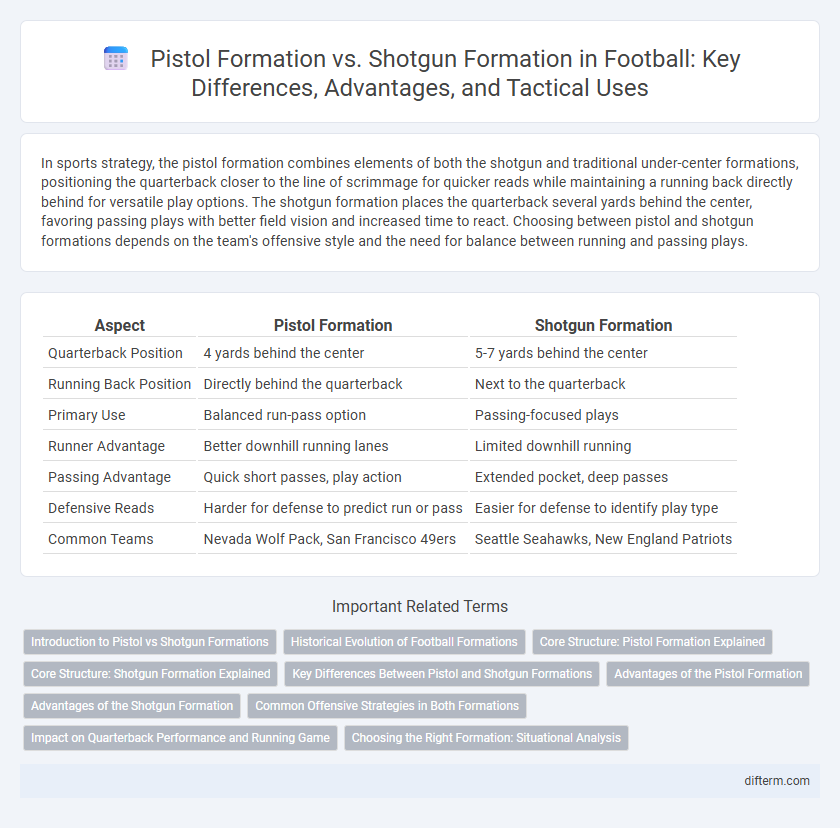In sports strategy, the pistol formation combines elements of both the shotgun and traditional under-center formations, positioning the quarterback closer to the line of scrimmage for quicker reads while maintaining a running back directly behind for versatile play options. The shotgun formation places the quarterback several yards behind the center, favoring passing plays with better field vision and increased time to react. Choosing between pistol and shotgun formations depends on the team's offensive style and the need for balance between running and passing plays.
Table of Comparison
| Aspect | Pistol Formation | Shotgun Formation |
|---|---|---|
| Quarterback Position | 4 yards behind the center | 5-7 yards behind the center |
| Running Back Position | Directly behind the quarterback | Next to the quarterback |
| Primary Use | Balanced run-pass option | Passing-focused plays |
| Runner Advantage | Better downhill running lanes | Limited downhill running |
| Passing Advantage | Quick short passes, play action | Extended pocket, deep passes |
| Defensive Reads | Harder for defense to predict run or pass | Easier for defense to identify play type |
| Common Teams | Nevada Wolf Pack, San Francisco 49ers | Seattle Seahawks, New England Patriots |
Introduction to Pistol vs Shotgun Formations
The pistol formation positions the quarterback about 4 yards behind the center, blending the shotgun's deep setup with the single-back's balanced running advantage. This alignment enhances both passing effectiveness and running versatility by allowing quicker handoffs and improved read options. In contrast, the shotgun formation places the quarterback 5 to 7 yards behind the center, emphasizing a pass-heavy strategy with increased visibility of the defense and faster reaction time.
Historical Evolution of Football Formations
The pistol formation emerged in the early 2000s as an innovative hybrid blending elements of the shotgun and single back formations, allowing quarterbacks to be closer to the line of scrimmage while maintaining a strong running threat. Historically, the shotgun formation dates back to the 1960s and revolutionized offensive strategy by positioning the quarterback several yards behind the center to enhance passing efficiency. Over decades, evolution from traditional under-center formations to pistol and shotgun variations has significantly shaped modern football tactics, emphasizing versatility and deceptive play execution.
Core Structure: Pistol Formation Explained
The pistol formation features the quarterback positioned about four yards behind the center, with the running back aligned directly behind the quarterback, enabling a balanced blend of passing and running plays. This core structure allows for a quicker handoff and maintains the advantages of the shotgun's passing depth while improving downhill running opportunities compared to the traditional shotgun formation. Teams leverage the pistol formation to create versatile offensive schemes that keep defenses guessing, optimizing both run and pass efficiency.
Core Structure: Shotgun Formation Explained
Shotgun formation positions the quarterback several yards behind the center, allowing for better field vision and quicker passes compared to the pistol formation, where the quarterback lines up closer to the line of scrimmage. This core structure facilitates a more dynamic aerial attack, enhancing the effectiveness of passing plays and spread offenses. Teams often use the shotgun to exploit defensive gaps with fast decision-making and multiple receiving options.
Key Differences Between Pistol and Shotgun Formations
The pistol formation positions the quarterback about 4 yards behind the center, blending elements of both shotgun and under-center formations, enhancing running and play-action passing. The shotgun formation places the quarterback 5-7 yards behind the center, prioritizing a clear view of the defense for quicker passing plays. Key differences include the pistol's closer quarterback depth aiding a balanced run-pass option and the shotgun's deeper placement benefiting faster pass releases and wider receiver spreads.
Advantages of the Pistol Formation
The pistol formation offers a balanced attack by positioning the quarterback closer to the line of scrimmage, enabling quicker handoffs and faster decision-making. This formation enhances the running game while maintaining effective passing options, creating confusion for defense against both run and pass plays. It also provides improved visibility and timing for the quarterback compared to the shotgun formation, leading to more efficient offensive execution.
Advantages of the Shotgun Formation
The shotgun formation offers quarterbacks enhanced visibility and increased reaction time by positioning them several yards behind the center, allowing better anticipation of defensive schemes. This setup facilitates a quicker release on passing plays and provides a strategic advantage in executing spread offenses with multiple wide receivers. The formation reduces the risk of defensive pressure, improving passing efficiency and creating diverse play-calling opportunities in both professional and collegiate football.
Common Offensive Strategies in Both Formations
Pistol and shotgun formations both emphasize passing and quick decision-making, with the pistol providing a more balanced threat between run and pass due to the quarterback's closer position to the line of scrimmage. Common offensive strategies include utilizing the shotgun formation for spread passing attacks and read-option plays, while the pistol formation often incorporates downhill running plays alongside play-action passes. Teams exploit the pistol's versatility to disguise intentions, benefiting from a compact backfield that enhances both short-yardage rushing and explosive passing opportunities.
Impact on Quarterback Performance and Running Game
The pistol formation enhances quarterback performance by positioning the quarterback closer to the line of scrimmage, allowing for quicker reads and faster decision-making compared to the shotgun formation. This alignment also benefits the running game by enabling a downhill running style and improving blocking angles, leading to more effective rushing plays. In contrast, the shotgun formation provides greater passing visibility but can limit the quarterback's ability to quickly execute running plays.
Choosing the Right Formation: Situational Analysis
Choosing the right formation in football hinges on situational factors such as down, distance, and defensive alignment. The pistol formation blends shotgun depth with a running back positioned directly behind the quarterback, ideal for balanced read options and quick handoffs. The shotgun formation, by placing the quarterback farther from the line of scrimmage, excels in passing situations requiring extra time for route development and defensive reading.
pistol formation vs shotgun formation Infographic

 difterm.com
difterm.com